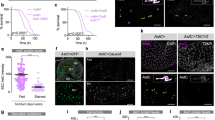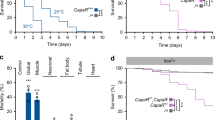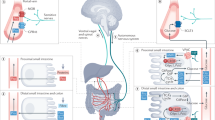Abstract
THE removal of the pituitary has contributed to the understanding of the endocrinology of many groups of vertebrates. However, ablation of what is probably the most primitive extant pituitary1,2, namely that of a myxinoid cyclostome, has, to the best of our knowledge, not yet been reported.
This is a preview of subscription content, access via your institution
Access options
Subscribe to this journal
Receive 51 print issues and online access
$199.00 per year
only $3.90 per issue
Buy this article
- Purchase on Springer Link
- Instant access to full article PDF
Prices may be subject to local taxes which are calculated during checkout
Similar content being viewed by others
References
Olsson, R., Zschr. Zellforsch., 51, 97 (1959).
Matty, A. J., Nature, 185, 180 (1960).
Adam, H., Schirner, H., and Walvig, F., Zool. Anz., 168, 216 (1962).
Falkmer, S., and Wimbladh, L., Proc. Intern. Symp. Str. Metab. Pancr. Islets, Uppsala-Stockholm, 1963, 17, 33 (Pergamon Press, Oxford, 1964).
Young, J. Z., J. Exp. Biol., 12, 261 (1935).
Dodd, J. M., Evennett, P. J., and Goddard, C. K., Symp. Zool. Soc. Lond., 1, 77 (1960).
Adam, H., in The Biology of Myxine, edit. by Brodal, A., and Fange, R., Ch. 7, p. 459 (Universitetsforlaget, Oslo, 1963).
Author information
Authors and Affiliations
Rights and permissions
About this article
Cite this article
MATTY, A., FALKMER, S. Hypophysectomy and Blood Sugar Regulation in a Cyclostome, Myxine glutinosa. Nature 207, 533–534 (1965). https://doi.org/10.1038/207533a0
Published:
Issue Date:
DOI: https://doi.org/10.1038/207533a0
This article is cited by
-
Experimental studies on the light sense in the hagfish,Eptatretus burgeri andParamyxine atami (Cyclostomata)
Helgoländer Wissenschaftliche Meeresuntersuchungen (1978)
Comments
By submitting a comment you agree to abide by our Terms and Community Guidelines. If you find something abusive or that does not comply with our terms or guidelines please flag it as inappropriate.



